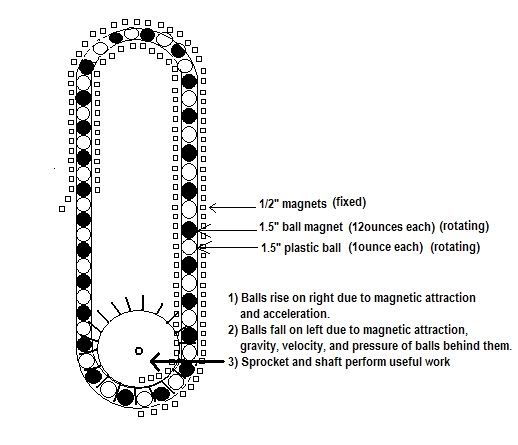Hi Peter and all,
I heard the interview with you and Stirling.
Heard you were doing research on the gravity engines.
Well I have been doing some work on that as well.
Here you can see an idea I had.
http://home.planet.nl/~sintt000/MagneticWheel.wmv
The balls on rods are just (big) iron bearings and make the loop up to the ‘sticky point’ and stay there. Which is the problem of most of these things. But in my case you can see that the magnets after top dead center are getting weaker. But still the ‘sticky spot’ will hold the ball. Well now we insert more balls and these travel also up to the ball that was inserted first. And this adds up in weight pushing on the first ball held by the ‘sticky point’ well until a certain amount of weight on the first ball is reached it will overcome the ‘sticky point’s holding force’ and get the system into motion. On top of that you have the centrifugal ‘force’ which is build up in a rotating ball and is released when it smashed into the stationary balls. Its momentum is transferred trough all the balls in the row to the last one. This introduces a kick off action.
Kinda like these desktop toys with a couple swinging metal balls.
http://www1.istockphoto.com/file_thu...n_s_cradle.jpg
And
billard ball pendulum
Well maybe it is of some help.
And mind you, yes the balls do travel up and past top dead center. I have tried that at least. And with balls of 25mm diameter is works ok. But I only have like 3 of these balls (out of a big broken ball bearing) so I cannot test it any better at this point. Also you need a lot of magnets…
But the concept could be useful?
Kind regards,
Steven
I heard the interview with you and Stirling.
Heard you were doing research on the gravity engines.
Well I have been doing some work on that as well.
Here you can see an idea I had.
http://home.planet.nl/~sintt000/MagneticWheel.wmv
The balls on rods are just (big) iron bearings and make the loop up to the ‘sticky point’ and stay there. Which is the problem of most of these things. But in my case you can see that the magnets after top dead center are getting weaker. But still the ‘sticky spot’ will hold the ball. Well now we insert more balls and these travel also up to the ball that was inserted first. And this adds up in weight pushing on the first ball held by the ‘sticky point’ well until a certain amount of weight on the first ball is reached it will overcome the ‘sticky point’s holding force’ and get the system into motion. On top of that you have the centrifugal ‘force’ which is build up in a rotating ball and is released when it smashed into the stationary balls. Its momentum is transferred trough all the balls in the row to the last one. This introduces a kick off action.
Kinda like these desktop toys with a couple swinging metal balls.
http://www1.istockphoto.com/file_thu...n_s_cradle.jpg
And
billard ball pendulum
Well maybe it is of some help.
And mind you, yes the balls do travel up and past top dead center. I have tried that at least. And with balls of 25mm diameter is works ok. But I only have like 3 of these balls (out of a big broken ball bearing) so I cannot test it any better at this point. Also you need a lot of magnets…
But the concept could be useful?
Kind regards,
Steven














Comment